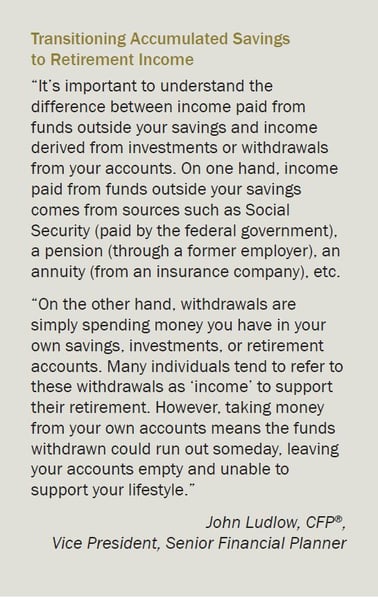5 min read
Explore Ways to Generate and Protect Retirement Income
 John Ludlow
:
Mar 15, 2023 2:00:00 PM
John Ludlow
:
Mar 15, 2023 2:00:00 PM

Throughout your adult life, you’ve worked hard and saved diligently for your retirement. Now that you’re enjoying this exciting stage of your life, it’s time to turn your attention to making sure your savings can help support the lifestyle you’ve imagined for the years ahead.

Here are some tips to keep in mind regarding how to generate and protect your income during retirement.
Generating income: Set up a ‘paycheck’ using your retirement savings
To provide a steady flow of income and avoid running out of money in retirement, here are a few ways you can transition your accumulated savings to maintain the lifestyle you desire.
Savings/money markets: One traditional way to get income from your savings is to make deposits into savings or money market accounts. These accounts protect your savings from market losses while paying a nominal level of interest. The good news here is interest rates on savings and money markets are starting to increase. So, unlike the past 15 years or so, you can actually earn tangible interest on your cash holdings.
CDs: A bank CD (certificate of deposit) is another traditional way to protect your savings while earning some interest. Longer-term CDs may even pay interest to you on a semi-annual or monthly basis. You can buy CDs for a very short period of time (such as a few months) or up to many years. Keep in mind CDs require you to give up your ability to withdraw the funds until the CD matures — otherwise, you’ll pay a large penalty. Again, the good news here is banks and brokerage firms are starting to pay higher rates on the CDs they offer.
Bonds: A slightly more complicated way to create retirement income is to invest in bonds. Bonds are issued by the federal and lower levels of government, as well as corporations, as a means for you to essentially lend them money. You invest in a bond at $1,000 increments and, in return, the issuer promises to pay you a specified amount of interest for a set period of time. Typically, interest is paid back to you every six months. You get your $1,000 back when the bond matures at the end of its term.
Dividends: Many investors are attracted to stock dividends to provide income from investments. When you invest in a dividend-paying company you benefit from any appreciation in the stock price and get distributions in the form of dividends (a share of the company’s revenue). However, unlike interest from bonds, dividends are not guaranteed and can be reduced or even eliminated completely. Also, you could experience losses on the principal of your investment if the price of your stock drops.
Income annuities: Fixed-income annuities are another popular way to provide income in retirement. Think of an income annuity as a self-funded pension. You invest a lump-sum into an annuity contract and in return an insurance company agrees to pay you a stream of specified monthly income for life or a specified amount of time. Unlike other methods of investment income, a lifetime annuity will keep paying income to you after you have gotten back all your initial investment.
Alternative Investments: Non-traditional investments such as Real Estate Investment Trusts (REITs), Master Limited Partnerships, and Unit-Investment Trusts generally provide a relatively high level of income for your investment. However, these investments typically are complex and illiquid — be sure to get all information available from your advisor before using your savings for this kind of investment.
Protecting income: Your retirement may last awhile
Plan for health care costs: One way a retirement lifestyle can be put in jeopardy quickly is if you experience escalating costs associated with your health. Planning for these costs can make a big difference in mitigating the expected and unexpected costs of maintaining your health. Retirees under age 65 should explore the best options for paying for a health plan that fits into their budget before Medicare eligibility. Retirees can also investigate long-term care (LTC) insurance or other options to provide for their own care later in life.
Invest for growth: Consider your retirement as the beginning of your next phase in life that could last another 30 years or more. As such, you want to make sure your investments are structured to ensure a proper growth level throughout all those years. Resist the urge to reduce your investment risk too low. Instead, work with a qualified portfolio manager to determine the best investment growth level for your investments. In the end, a diversified growth component of your accounts could help you keep up with inflation and provide the assets you need throughout your retirement.
Make systematic withdrawals: Set a specific withdrawal amount from your savings and investment accounts each month to spend. Typically, this amount can be transferred directly to your checking account and act as a self-funded ‘paycheck’ for you to live on. Also, taxes can be withheld when taking these withdrawals from retirement accounts. Keep withdrawals at a sustainable level determined by you and your advisor to make sure your accounts don’t drain too quickly.
Plan your Social Security income strategy: Social Security can be tricky — you can start taking your benefit as early as age 62. However, the earlier you take your benefit, the less monthly income you receive. For each year you wait to begin taking your Social Security income, you’ll get an 8% increase in the monthly amount you’re paid. Once you start your income benefit, you’re subject to annual cost of living adjustments determined by the government. (There’s been a yearly increase of about 2% over the past 10 years.) The longer you wait to take Social Security the better — that way, this part of your retirement income can help support your lifestyle long-term. Again, work with your advisor to determine the best timing for you and your retirement plan.
Consider other ways to make your money last longer
Don’t rule out other ways to make your money last longer in retirement. You might want to consider:
Working in retirement: Finding an enjoyable job with flexible hours is a great way to share your skills and passions, interact with other people, and generate a little bit of income to take the pressure off your own savings. If you are receiving Social Security retirement benefits and are not yet full retirement age, there are annual limits before you will see a reduction in Social Security benefits.
Volunteering: While volunteering doesn’t pay income, it does keep you busy. Helping out at a favorite local charity with a worthy cause could keep you from finding new ways to spend more money than you had planned.
Decreasing your spending: You may be able to reduce your spending once you’re retired. Take a look at your monthly expenses and decide where you can make some changes in your spending habits. Reducing personal spending is like giving yourself a tax-free raise.
Carefully consider these — and all — your retirement income options
Bottom line, everyone’s retirement is different. That’s why it’s important to work with an advisor to determine the retirement income options best suited for your unique financial situation.
Contact Commerce Trust today. Discover firsthand how our team of professionals listens to your concerns, offers guidance with your financial planning, and explores potential opportunities for growing your wealth with personalized strategies that will generate and protect your income stream in retirement.
To provide a steady flow of income and avoid running out of money in retirement, here are a few ways you can transition your accumulated savings to maintain the lifestyle you desire.
Savings/money markets: One traditional way to get income from your savings is to make deposits into savings or money market accounts. These accounts protect your savings from market losses while paying a nominal level of interest. The good news here is interest rates on savings and money markets are starting to increase. So, unlike the past 15 years or so, you can actually earn tangible interest on your cash holdings.
CDs: A bank CD (certificate of deposit) is another traditional way to protect your savings while earning some interest. Longer-term CDs may even pay interest to you on a semi-annual or monthly basis. You can buy CDs for a very short period of time (such as a few months) or up to many years. Keep in mind CDs require you to give up your ability to withdraw the funds until the CD matures — otherwise, you’ll pay a large penalty. Again, the good news here is banks and brokerage firms are starting to pay higher rates on the CDs they offer.
Bonds: A slightly more complicated way to create retirement income is to invest in bonds. Bonds are issued by the federal and lower levels of government, as well as corporations, as a means for you to essentially lend them money. You invest in a bond at $1,000 increments and, in return, the issuer promises to pay you a specified amount of interest for a set period of time. Typically, interest is paid back to you every six months. You get your $1,000 back when the bond matures at the end of its term.
Dividends: Many investors are attracted to stock dividends to provide income from investments. When you invest in a dividend-paying company you benefit from any appreciation in the stock price and get distributions in the form of dividends (a share of the company’s revenue). However, unlike interest from bonds, dividends are not guaranteed and can be reduced or even eliminated completely. Also, you could experience losses on the principal of your investment if the price of your stock drops.
Income annuities: Fixed-income annuities are another popular way to provide income in retirement. Think of an income annuity as a self-funded pension. You invest a lump-sum into an annuity contract and in return an insurance company agrees to pay you a stream of specified monthly income for life or a specified amount of time. Unlike other methods of investment income, a lifetime annuity will keep paying income to you after you have gotten back all your initial investment.
Alternative Investments: Non-traditional investments such as Real Estate Investment Trusts (REITs), Master Limited Partnerships, and Unit-Investment Trusts generally provide a relatively high level of income for your investment. However, these investments typically are complex and illiquid — be sure to get all information available from your advisor before using your savings for this kind of investment.
Protecting income: Your retirement may last awhile
Plan for health care costs: One way a retirement lifestyle can be put in jeopardy quickly is if you experience escalating costs associated with your health. Planning for these costs can make a big difference in mitigating the expected and unexpected costs of maintaining your health. Retirees under age 65 should explore the best options for paying for a health plan that fits into their budget before Medicare eligibility. Retirees can also investigate long-term care (LTC) insurance or other options to provide for their own care later in life.
Invest for growth: Consider your retirement as the beginning of your next phase in life that could last another 30 years or more. As such, you want to make sure your investments are structured to ensure a proper growth level throughout all those years. Resist the urge to reduce your investment risk too low. Instead, work with a qualified portfolio manager to determine the best investment growth level for your investments. In the end, a diversified growth component of your accounts could help you keep up with inflation and provide the assets you need throughout your retirement.
Make systematic withdrawals: Set a specific withdrawal amount from your savings and investment accounts each month to spend. Typically, this amount can be transferred directly to your checking account and act as a self-funded ‘paycheck’ for you to live on. Also, taxes can be withheld when taking these withdrawals from retirement accounts. Keep withdrawals at a sustainable level determined by you and your advisor to make sure your accounts don’t drain too quickly.
Plan your Social Security income strategy: Social Security can be tricky — you can start taking your benefit as early as age 62. However, the earlier you take your benefit, the less monthly income you receive. For each year you wait to begin taking your Social Security income, you’ll get an 8% increase in the monthly amount you’re paid. Once you start your income benefit, you’re subject to annual cost of living adjustments determined by the government. (There’s been a yearly increase of about 2% over the past 10 years.) The longer you wait to take Social Security the better — that way, this part of your retirement income can help support your lifestyle long-term. Again, work with your advisor to determine the best timing for you and your retirement plan.
Consider other ways to make your money last longer
Don’t rule out other ways to make your money last longer in retirement. You might want to consider:
Working in retirement: Finding an enjoyable job with flexible hours is a great way to share your skills and passions, interact with other people, and generate a little bit of income to take the pressure off your own savings. If you are receiving Social Security retirement benefits and are not yet full retirement age, there are annual limits before you will see a reduction in Social Security benefits.
Volunteering: While volunteering doesn’t pay income, it does keep you busy. Helping out at a favorite local charity with a worthy cause could keep you from finding new ways to spend more money than you had planned.
Decreasing your spending: You may be able to reduce your spending once you’re retired. Take a look at your monthly expenses and decide where you can make some changes in your spending habits. Reducing personal spending is like giving yourself a tax-free raise.
Carefully consider these — and all — your retirement income options
Bottom line, everyone’s retirement is different. That’s why it’s important to work with an advisor to determine the retirement income options best suited for your unique financial situation.
Contact Commerce Trust today. Discover firsthand how our team of professionals listens to your concerns, offers guidance with your financial planning, and explores potential opportunities for growing your wealth with personalized strategies that will generate and protect your income stream in retirement.
Download the Article
Certified Financial Planner Board of Standards, Inc. (CFP Board) owns the certification marks CFP® and CERTIFIED FINANCIAL PLANNER™ in the United States, which it authorizes use of by individuals who successfully complete CFP Board’s initial and ongoing certification requirements.
The opinions and other information in the commentary are provided as of March 15, 2023. This summary is intended to provide general information only, and may be of value to the reader and audience.
This material is not a recommendation of any particular investment or insurance strategy, is not based on any particular financial situation or need, and is not intended to replace the advice of a qualified tax advisor or investment professional. While Commerce may provide information or express opinions from time to time, such information or opinions are subject to change, are not offered as professional tax, insurance or legal advice, and may not be relied on as such.
Past Performance is not a guarantee of future results. Diversification does not guarantee a profit or protect against all risk.
Data contained herein from third-party providers is obtained from what are considered reliable sources. However, its accuracy, completeness or reliability cannot be guaranteed.
Certified Financial Planner Board of Standards, Inc. (CFP Board) owns the certification marks CFP® and CERTIFIED FINANCIAL PLANNER™ in the United States, which it authorizes use of by individuals who successfully complete CFP Board’s initial and ongoing certification requirements.
The opinions and other information in the commentary are provided as of March 15, 2023. This summary is intended to provide general information only, and may be of value to the reader and audience.
This material is not a recommendation of any particular investment or insurance strategy, is not based on any particular financial situation or need, and is not intended to replace the advice of a qualified tax advisor or investment professional. While Commerce may provide information or express opinions from time to time, such information or opinions are subject to change, are not offered as professional tax, insurance or legal advice, and may not be relied on as such.
Past Performance is not a guarantee of future results. Diversification does not guarantee a profit or protect against all risk.
Data contained herein from third-party providers is obtained from what are considered reliable sources. However, its accuracy, completeness or reliability cannot be guaranteed.
